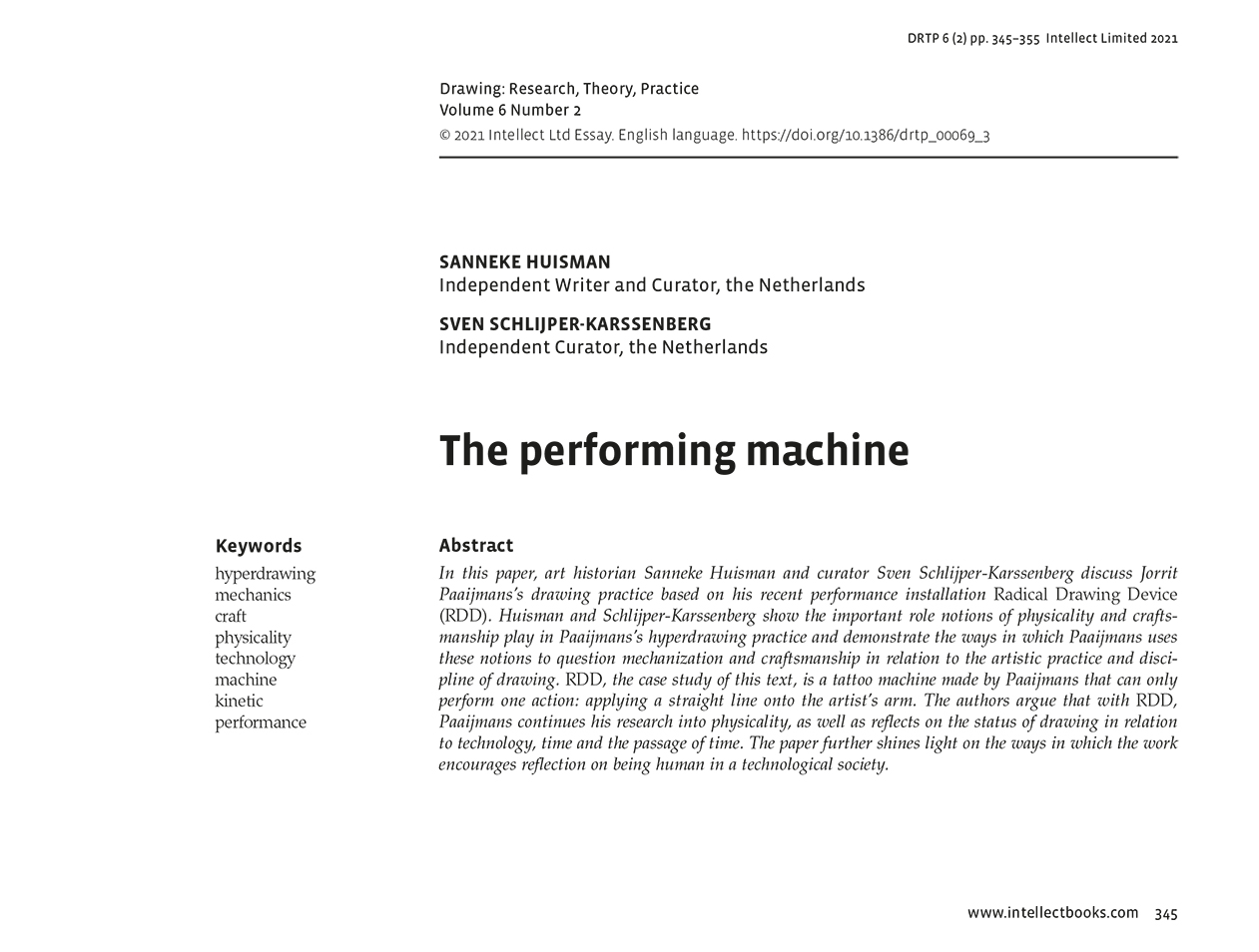
Essay ‘The Performing Machine’ Authors: Huisman, Sanneke; Schlijper-Karssenberg, Sven;
Source: Drawing: Research, Theory, Practice, DRTP 6.2, Volume 6, Number 2, 1 December 2021, pp. 345-355(11) ISSN 2057-0384 (Print); ISSN 2057-0392 (Online) Publisher: Intellect [UK]
Authors: Sanneke Huisman, Sven Schlijper-Karssenberg
Abstract:
In this article art historian Sanneke Huisman and curator Sven Schlijper-Karssenberg discuss Jorrit Paaijmans’s drawing practice based on his recent performance installation Radical Drawing Device (RDD). Huisman and Schlijper-Karssenberg show the important role notions of physicality and craftsmanship play in Paaijmans’s hyperdrawing practice and demonstrate the ways in which Paaijmans uses these notions to question mechanization and craftsmanship in relation to the artistic practice and discipline of drawing. RDD, the case study of this text, is a tattoo machine made by Paaijmans that can only perform one action: applying a straight line onto the artist’s arm. The authors argue that with RDD, Paaijmans continues his research into physicality, as well as reflects on the status of drawing in relation to technology, time and the passage of time. The paper further shines light on the ways in which the work encourages reflection on being human in a technological society.
This journal and the paper are both for sale at intellectbooks.com through there sales-platform ingenta connect please click below for a direct >>
https://www.ingentaconnect.com/content/intellect/drtp/2021/00000006/00000002
https://www.ingentaconnect.com/contentone/intellect/drtp/2021/00000006/00000002/art00007
For more information about the journal and issue click here >>
https://www.intellectbooks.com/drawing-research-theory-practice
Drawing: Research, Theory, Practice is dedicated to the promotion and dissemination of drawing practice and research in its current cultural and disciplinary diversity, with a focus on contemporary practice and its theoretical context. Delivered in print, the journal re-establishes the materiality of drawing at a time when virtual, online electronic formats dominate the field of contemporary visual culture.
A peer-reviewed academic publication, the journal encourages pluralist forms of discourse that reflect the evolving relationships between drawing practice and theory and their representation in research. It aims to be a forum for engaging interdisciplinary debates on the ways in which drawing functions in contemporary culture – as experimental practice, process, performance or product; as visual narrative, methodology, cognitive process, representation, documentation, recording or communication tool; as an investigative, descriptive or interpretive pursuit; as a site of conception and production, critical thinking or discursive exploration – addressing current issues, traditional concepts and histories.
The journal content – including articles, critical essays, research projects and reports, artist and practice profiles, original visual material, featured drawings, book, conference, event and exhibition reviews – addresses the roles, functions, values and cultural significance of drawing in a multidisciplinary context. It presents drawing as a discipline in its own right and in a diversity of forms across fine art, architecture, design, craft, animation, media and visual communication, social and cultural practices, psychology, science, and technology. DRTP invites practitioners, researchers, educators and theorists to make contributions that deal with the various knowledges and representations of drawing.
Source: Drawing: Research, Theory, Practice, DRTP 6.2, Volume 6, Number 2, 1 December 2021, pp. 345-355(11) ISSN 2057-0384 (Print); ISSN 2057-0392 (Online) Publisher: Intellect [UK]
Authors: Sanneke Huisman, Sven Schlijper-Karssenberg
Abstract:
In this article art historian Sanneke Huisman and curator Sven Schlijper-Karssenberg discuss Jorrit Paaijmans’s drawing practice based on his recent performance installation Radical Drawing Device (RDD). Huisman and Schlijper-Karssenberg show the important role notions of physicality and craftsmanship play in Paaijmans’s hyperdrawing practice and demonstrate the ways in which Paaijmans uses these notions to question mechanization and craftsmanship in relation to the artistic practice and discipline of drawing. RDD, the case study of this text, is a tattoo machine made by Paaijmans that can only perform one action: applying a straight line onto the artist’s arm. The authors argue that with RDD, Paaijmans continues his research into physicality, as well as reflects on the status of drawing in relation to technology, time and the passage of time. The paper further shines light on the ways in which the work encourages reflection on being human in a technological society.
This journal and the paper are both for sale at intellectbooks.com through there sales-platform ingenta connect please click below for a direct >>
https://www.ingentaconnect.com/content/intellect/drtp/2021/00000006/00000002
https://www.ingentaconnect.com/contentone/intellect/drtp/2021/00000006/00000002/art00007
For more information about the journal and issue click here >>
https://www.intellectbooks.com/drawing-research-theory-practice
Drawing: Research, Theory, Practice is dedicated to the promotion and dissemination of drawing practice and research in its current cultural and disciplinary diversity, with a focus on contemporary practice and its theoretical context. Delivered in print, the journal re-establishes the materiality of drawing at a time when virtual, online electronic formats dominate the field of contemporary visual culture.
A peer-reviewed academic publication, the journal encourages pluralist forms of discourse that reflect the evolving relationships between drawing practice and theory and their representation in research. It aims to be a forum for engaging interdisciplinary debates on the ways in which drawing functions in contemporary culture – as experimental practice, process, performance or product; as visual narrative, methodology, cognitive process, representation, documentation, recording or communication tool; as an investigative, descriptive or interpretive pursuit; as a site of conception and production, critical thinking or discursive exploration – addressing current issues, traditional concepts and histories.
The journal content – including articles, critical essays, research projects and reports, artist and practice profiles, original visual material, featured drawings, book, conference, event and exhibition reviews – addresses the roles, functions, values and cultural significance of drawing in a multidisciplinary context. It presents drawing as a discipline in its own right and in a diversity of forms across fine art, architecture, design, craft, animation, media and visual communication, social and cultural practices, psychology, science, and technology. DRTP invites practitioners, researchers, educators and theorists to make contributions that deal with the various knowledges and representations of drawing.

